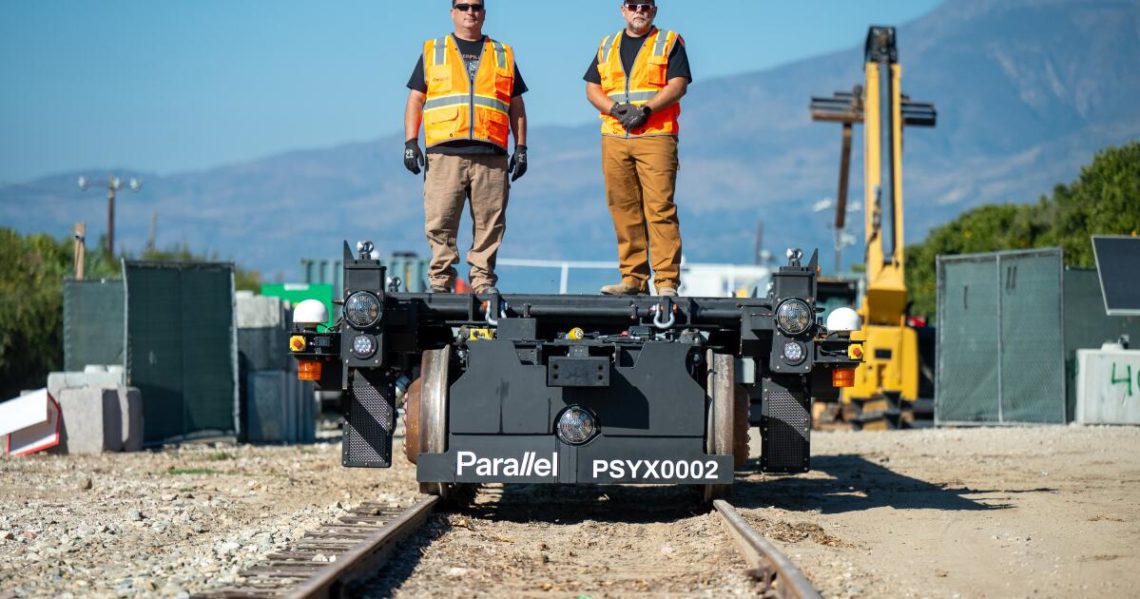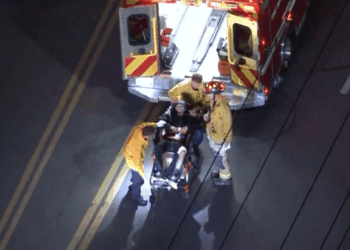Tucked away off Highway 126, on a network of railway tracks sometimes used to shoot movies, a local startup is testing what it says is the future of transportation: driverless freight trains.
Parallel Systems is using three miles of track outside Fillmore, Calif., to develop an automated, battery-powered railway car as a green alternative to the thousands of trucks that sit idling for hours at ports every day.
Down a dirt road and among fruit trees and farm animals, one of the gray and black prototypes sat silently on the test rails on a recent morning.
“We’re the Waymo of freight rail,” said Matt Soule, Parallel’s founder and chief executive. “We are developing this technology to increase market share for rail and to make freight transportation safer and cleaner.”
Parallel Systems is one of many companies hoping to use the latest battery technology and artificial intelligence to build fully autonomous vehicles that will change the way people and products are moved.
At the company’s headquarters, which is located in downtown L.A.’s Arts District, employees dressed in jeans and T-shirts work on developing a new train model for mass production. The headquarters includes low- and high-voltage labs and a small section of train track. In the airy warehouse space, cold brew flows on tap and a pingpong table sits unused.
Google’s Waymo, Tesla and others are tackling the robotaxi market while smaller startups, many of them also based in California, are focusing on other types of transportation. Torrance-based Arc Boats is building electric boats for water sports, and Mountain View’s Wisk Aero is developing electric and autonomous air taxis.
“Autonomy enables the improved service and flexibility necessary to compete for new business,” Soule said.
Parallel already raised $100 million and received approval from the Federal Railroad Administration to operate on shared railways. The train cars are about 44 feet long and sit low to the ground, ready to be top-loaded with a cargo container. Slightly shorter than a standard 50-foot freight car, the Parallel cars weigh roughly 40,000 pounds unloaded.
In Fillmore the vehicle is being tested without cargo at speeds up to 40 mph. The cars are much quieter than diesel-engine cars, the company said, but have a horn for crossings that meets federal requirements.
Each car has two motors powered by lithium-iron phosphate batteries and can haul a container 500 miles on a single charge. The cars are designed to travel in groups of up to 50, but also each can move independently.
Instead of using traditional railroad couplers or magnets to attach cars, the cars use their motors to stay connected. Sensors communicate with the motors to maintain a consistent speed across a line of railway cars, Soule said.
The company said it eventually could produce tens of thousands of units per year to meet the new demands of the railway market. It wouldn’t disclose how much the vehicles will cost.
Soule launched Parallel Systems in 2020 after spending 13 years at SpaceX. His team of around 50 includes former Rivian and Tesla engineers, as well as certified train conductors. He said the reimagined freight trains will increase railroad operating capacity, help take short-haul trucks off the road and reduce carbon emissions.
Railways are generally used by long trains hauling over long distances, which often leaves a lot of rail capacity unused. Driverless freight trains could make it economical to use shorter trains on shorter routes.
Meanwhile, America’s logistics network requires too many trucks — each requiring a driver— to converge on ports at the same time to take containers off cargo ships. This leads to big bottlenecks and long waits.
“The congestion that we all experience in California and the cost of transportation make this a natural birthplace to bring this into commercialization,” Soule said. “What would be moved by a truck from the ports of Los Angeles and Long Beach to the Inland Empire, we could have our technology moving instead.”
As his company grows, Soule has his sights set on launching in the Golden State. The trains are manufactured in Pacoima and shipped via truck to Fillmore and Georgia, where it already has trains on the tracks.
James Unger, manager of field operations at the Fillmore test site, brings traditional railroad experience to the company from his years at major railways. He and his team are developing rules to regulate how the trains move.
“I could see this being the future of a lot of railroad operations,” Unger said, wearing a neon safety vest and hard-toed boots.
Parallel Systems is the only company with federal approval to operate a commercial, autonomous railroad vehicle, according to Soule. The company has begun testing one of its trains in Georgia through a partnership with Genesee & Wyoming Railroad.
Near the Port of Savannah, Parallel System has entered its second phase of testing and plans to add three more vehicles next year.
Over a 30-mile portion of track, the company will evaluate autonomous system performance across different terrains and weather conditions. Engineers there are testing speed and position accuracy as well as stopping distance for the cars.
There are other self-operating trains across the globe, including the SkyTrain in Vancouver and at several airports, but most run on tracks only in closed systems. Parallel Systems is designing trains that ultimately will haul cargo alongside traditional rail cars.
It could be years before these robotrains become widespread. While programming them to move safely could be easier in ways than autonomous cars, the technology still is being perfected.
Truck drivers, railway workers and unions have expressed concerns about whether the technology will eliminate jobs for humans. There is also a big question of whether the country’s railway network is ready for the technology. Much of it has been shut or become outdated, said William Riggs, director of the Autonomous Vehicles and the City Initiative at the University of San Francisco.
“Automation of rail has been around for a long time,” he said. “The viability of this kind of technology is definitely there. Whether or not there’s a solid market for this, I think it’s to be determined.”
Transporting cargo by rail saves energy and lowers pollution and wear on roadways, Soule said. Because there is little friction between steel wheels and rail, it doesn’t take much force to transport 30-ton trailers on level tracks.
Parallel Systems plans to make money by marketing its technology directly to railroad companies such as G&W, which can then use the trains to expand their operations.
Parallel Systems still is working toward full autonomy. The freight trains will be equipped with cameras and sensors as well as a laser-based radar called lidar, which also is used in Waymo’s self-driving cars. The trains also will rely on machine learning to operate.
Developing autonomy for a rail system is drastically different than building a driverless car because there are different variables and the technology has to adapt to a strict preexisting system, Soule said.
While some may be worried they could lose their jobs to the trains, Soule said his company’s trains will create human jobs doing things such as oversight and cargo-handling. Trucks still will be needed for deliveries, but the trains could take over the containers from smaller depots.
“This is a new type of service that allows railroads to compete in ways they couldn’t before,” Soule said of his company’s product. “This is a technology that is understanding the environment around it and reacting to it.”
The post Driverless freight trains on Southern California rails? This L.A. startup is already testing them appeared first on Los Angeles Times.




